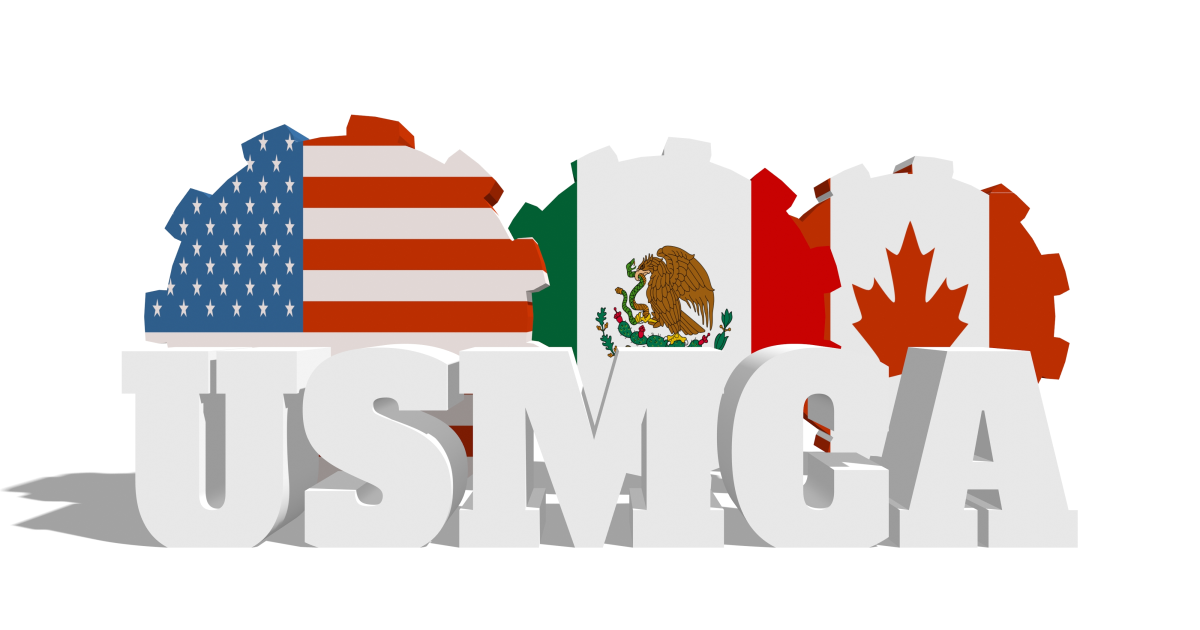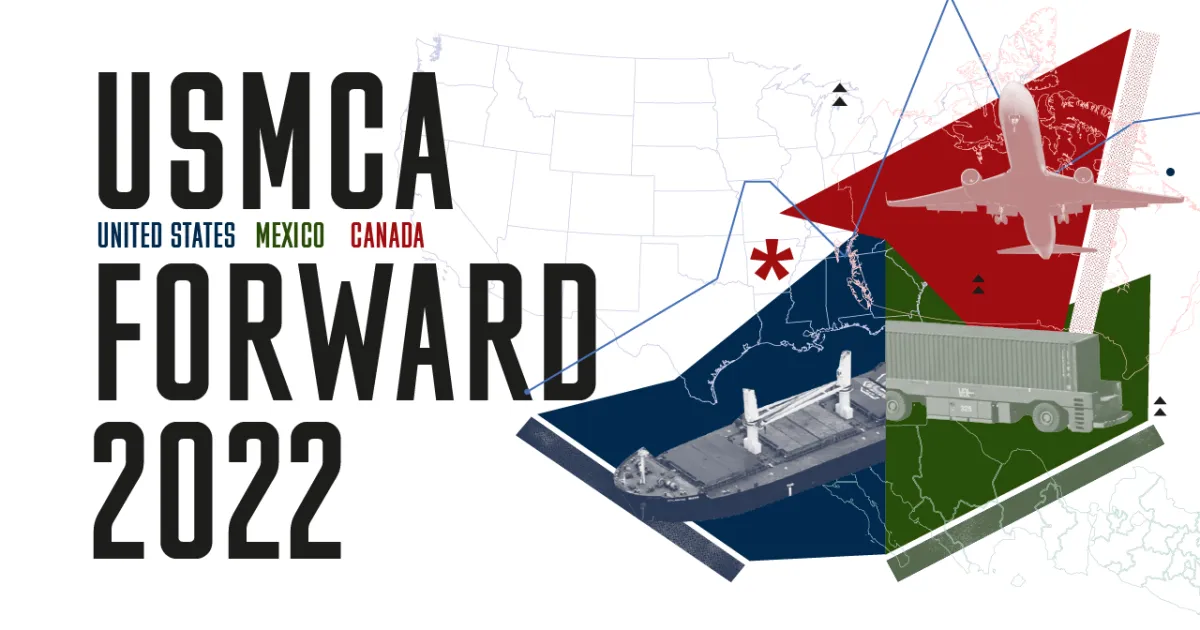
CHAPTER 1
NATIONAL SECURITY
The USMCA plays a national security role
Looking at the political backdrop in which it was ratified in 1994, the North American Free Trade Agreement (NAFTA) came at a unique historic moment; the security threat from the Soviet Union had receded and one from a rising China was not yet apparent. NAFTA reflected an understandable focus on economic development and encouraging mutually beneficial trade relationships.1
Thirty years since NAFTA’s ratification, while globalized markets and supply chains have multiplied and become more complex, geopolitical conflict has also become more prevalent. This simultaneous growth in interdependence and tension has created U.S. vulnerability from economic reliance on actors such as China.2 China is both the world’s largest trading nation and an aggressive military and political competitor with the United States. The intersection between very complex supply chains and national security vulnerability is stronger than it has ever been.3 While these dynamics are most notable in relationships with China, they are in fact present in other regions.
NAFTA’s successor, the U.S.-Mexico- Canada Agreement (USMCA), is similar to NAFTA but includes important additional commitments on the environment and labor. This piece will discuss how developing closer economic ties across North America also has an important security dimension. In fact, USMCA plays a crucial role for all three parties in terms of mitigating the risks associated with economic interdependence with strategic competitors, primarily China.
A new era: Global interdependence, while in some respects beneficial, also creates vulnerability
Defining national security solely in terms of military power–or even political or diplomatic influence–does not reflect the many ways critical national interests may be threatened or advanced. While “national interest” is not coextensive with “national security,” nations face the challenge of sometimes interconnected military, economic, diplomatic, and political considerations that might have been separable in earlier eras.4
Economic actors–companies, labor markets, and governments–rely on globally efficient and intertwined supply chains to deliver products. These highly interconnected supply chains are a fact of life, and in many ways beneficial. Highly interconnected global trade has, among other things, reduced global poverty by distributing capital and labor to places where it is most efficiently used.5
But, with benefit comes vulnerability. Dispersed supply chains develop because actors find it economically advantageous to seek the least expensive and most productive sources of supply. While this may be individually beneficial for some actors, pursuit of least-costly and most efficient supply chains is not necessarily consistent with collective national security needs. Indeed, Individual optimization of supply chains can create vulnerabilities more broadly. For instance, disruptions in supply chains, whether from malign human action or natural disasters, are rarely confined to a single company and can have broader economic impacts.6
In some cases, supply chain disruptions can have national security implications. These include pharmaceuticals7 and personal protective equipment,8 semiconductors used in multiple different systems to include military applications, energy, food, and raw materials used in manufacturing.9
The impact on vulnerable populations may be particularly severe. Supply chain disruptions cause higher prices and shortages among basic commodities such as generic drugs or canned food or energy, increasing the cost of living and provision of basic needs. While more affluent nations or individuals can often find ways to mitigate disruptions, those who start with fewer resources are the first to—and more severely—suffer than their wealthier counterparts.
Disrupted supply chains can set the stage for heightened tension, even open conflict
For the most part, nations will try to secure their supply chains by peaceful means such as stockpiling, direct investment in partner nations, and use of other financial incentives.
However, if supply chain disruptions become chronic and severe, more aggressive actions might be initiated. International competition becomes a matter of using national power to ensure access to resources.10 This might come in the form of military action, but it need not. Initiatives such as China’s “Belt and Road” initiative is an effort to both assure supply and transportation and deny the same to potential adversaries.11
This essay does not presume that the geopolitical interests of the United States perfectly intersect with those of Canada and Mexico.
What is also increasingly clear is that economic interdependence—which supply chains enable—will not necessarily pacify international relations and can instead be a source of risk and geopolitical tension.12 Such conflicts have occurred even during times of significant interdependence between nations, such as in the European system prior to World War I.13 Furthermore, aggressive action short of outright war can still be very dangerous for actors in the system.
Turning to a recent example, Taiwan currently dominates the market for semi-conductors, which in some respects gives it leverage with other actors, such as mainland China.14 However, this very dominance—plus Taiwan’s proximity to mainland China—may in fact raise the incentive for China to take aggressive military action against Taiwan to ensure access to semiconductors. Such action could range from a coercive “quarantine” to an actual invasion.15 Such actions would put semiconductor production at risk to the detriment of nearly every actor in the world economy–including China–but also possibly forcing a resolution on China’s terms. Both the cause and the resolution of this potential security challenge are the product of vulnerable overseas supply chains.
China as a unique actor and possible systemic destabilizer
China’s potential as a disrupter cannot be ignored. China is an economic powerhouse. Since 2014, China has become the world’s largest manufacturer and trading nation, which gives it unique influence.16 It is at the very center of several key supply chains– from rare earth processing and batteries to pharmaceuticals and medical devices—and is at least potentially able to use its influence to promote its geopolitical objectives.17
China’s leverage does not mean that it is free of exposure. Indeed, its status as a “workshop” requires that it has access to markets that allow export of its goods. Because China plays such a critical role in complex supply chains, just like the rest of the world, it is also subject to disruptions in unexpected ways. Indeed, the disruptions experienced during the COVID pandemic illustrate that there is much about these interactions that China itself did not understand.18 Moreover, just as China can use its dominance in parts of critical supply chains, the U.S. also has leverage in denying the export of intellectual property and advanced technology.19 Such sanctions affect all the parties involved, and the important point is that interdependence creates risks, as well as possibilities, for everyone.
USMCA, secure supply chains, and national security
This essay does not presume that the geopolitical interests of the United States perfectly intersect with those of Canada20 and Mexico.21 All three USMCA signatories have their own foreign policy and national goals. However, there is a common interest in ensuring the availability of key materials and the resilience of supply chains. Supply chain interdependence is a fact of life, which is very unlikely to change in the next generation.
China has multiple reasons and means for disrupting supply chains. USMCA may be very helpful in mitigating the temptation and ability for China to disrupt. It can do this in three major ways: Creating a common understanding of vulnerability among the three countries; promoting the location of critical supply chain sources within the territories of the three signatories; and demonstrating that supply chain interdependence can be managed within a cooperative trading bloc.
A common understanding of vulnerability
A characteristic of recent supply chain crises is that they occur in unexpected ways. When the COVID-19 pandemic began having a major global impact in March 2020, the world experienced shortages of ventilator parts, personal protective equipment, and nasal swabs, not just as demand exploded for these commodities but as the factories that produced them closed. These were only the first in a whole series of shortages of multiple commodities over the next two years. What they had in common was broad–and to a very large degree unexpected–systemic impact. Many of these vulnerabilities developed with no clear understanding that they were in fact developing.
USMCA can at a minimum provide a forum for nominating and assessing key challenges. The preamble for USMCA calls for measures to promote transparency and macroeconomic cooperation. USMCA already imposes rules of origin and tracking for automobiles and automobile parts, to include the provenance of raw materials. The tracking requirements are indeed held to be more stringent than NAFTA’s.22 While this tracking is in some ways onerous, it has the positive effect of more precisely identifying vulnerability. Requiring that origins be shown all the way back to production inputs and raw material no doubt is onerous, it is one very sure way of identifying where supplies may be vulnerable.
The promotion of ‘friend-shoring’
USMCA is best seen as a mechanism for ensuring free and fair trade between neighbors with shared borders and interests. However, the very existence of a market generally free of trade barriers may provide an opportunity for addressing critical supply chain threats.
Specifically, where there are known vulnerabilities in current supply chains, whether in raw material extraction, materials processing, manufacturing, or even transportation, a trade agreement that already provides a framework for governance and sourcing may be a real asset. What recent events have shown is that there are large and unappreciated risks for operating elsewhere. USMCA can make “friend-shoring” an attractive option for private actors.
The promotion of equity common values
The previous two recommendations were focused on using USMCA to improve visibility and understanding of supply chain vulnerabilities and thus more generally promote security in an interdependent world. USMCA has an additional value, which is to show that nations can arrive at common approaches to supply chains that protect national interests and do so without resorting to coercion, armed or otherwise. The partners work within a framework, allow for waivers and mitigations when some local interest might be damaged, and agree to a conflict resolution process that serves the interests of all parties. USMCA signatories are long-standing friends, so the model might not be as readily executed among other partners. But, the agreement does show that interdependence–even with the resulting vulnerabilities–does not have to result in conflict.
Endnotes
- 1. NAFTA in a Nutshell – LawNow Magazine
- 2. Varas, Antonio, Raj Varadarajan, Jimmy Goodrich, Falan Yinug, Strengthening the Global Semiconductor Supply Chain in an Uncertain Era, Boston Consulting Group and Semiconductor Industry Association, April 2021.
- 3. Feng, John, “Xi Jinping Says China to Become Dominant World Power within 30 Years,” Newsweek, July 1, 2021”
- 4. For our purposes, we will use Wikipedia’s compiled definition for national security: “National security is the requirement to maintain the survival of the state through the use of economic power, diplomacy, power projection and political power…. Accordingly, in order to possess national security, a nation needs to possess economic security, energy security, environmental security, etc.”
- 5. Globalization in Business With History and Pros and Cons (investopedia.com)
- 6. “Supply Chain Disruption–the Risk to Global Economic Recovery”, FTI Consulting, September 1 2022, https://www.fticonsulting.com/insights/articles/supply-chain-disruption-risk-global-economic-recovery
- 7. Judy Stone, “Fragile Antibiotics Supply Chain Causes Shortages and Is a National Security Threat”, Forbes, June 1, 2019, https://www.forbes.com/sites/judystone/2018/06/01/fragile-antibiotic-supply-chain-causes-shortages-and-is-a-national-security-threat/
- 8. Cyn Young-Park et al, “Global Shortage of Personal Protective Equipment Amid COVID-19: Supply Chains, Bottlenecks, and Policy Implications”, Asian Development Bank, April 2020, http://dx.doi.org/10.22617/BRF200128-2
- 9. FTI Consulting, https://www.fticonsulting.com/insights/articles/supply-chain-disruption-risk-global-economic-recovery
- 10. Choucri, N., & North, R. C. (1975). Nations in conflict: National growth and international violence. W. H. Freeman.
- 11. What is China’s Belt and Road Initiative (BRI)? | Chatham House – International Affairs Think Tank
- 12. Mamta Badkar, “Nine Wars That Were Really About Commodities”, Business Insider, August 15 2022, https://www.businessinsider.com/nine-wars-that-were-fought-over-commodities-2012-8
- 13. Nazli Choucri, “What is Lateral Pressure?”, Massachusetts Institute of Technology School of Political Science, Last revised August 6, 2022, http://nchoucri.mit.edu/theory/lateral-pressure
- 14. Yen Nee Lee, “2 Charts Show How Much the World Depends on Taiwan For Semiconductors”, CNBC, March 15, 2022, https://www.cnbc.com/2021/03/16/2-charts-show-how-much-the-world-depends-on-taiwan-for-semiconductors.html
- 15. Saibal Dasgupta, “Race For Semiconductors Influences Taiwan Conflict”, Voice of America News, August 10 2022, https://www.voanews.com/a/race-for-semiconductors-influences-taiwan-conflict-/6696432.html
- 16. “China and The World: Inside the Dynamics of a Changing Relationship”, McKinsey Global Institute, July 1 2019, https://www.mckinsey.com/featured-insights/china/china-and-the-world-inside-the-dynamics-of-a-changing-relationship
- 17. Scott Livingston, “The Chinese Communist Party Targets the Private Sector”, Center for Strategic and International Studies, October 8 2020, https://www.csis.org/analysis/chinese-communist-party-targets-private-sector
- 18. Michael Schuman, “Why China Is Still Imposing Lockdowns”, The Atlantic, September 9 2022, https://www.theatlantic.com/international/archive/2022/09/china-lockdowns-zero-covid-policy/671385
- 19. U.S. Sanctions Against China Are Working, Thanks To ASML (NASDAQ:ASML) | Seeking Alpha
- 20. Colin Scarffe, “The Canada-China Global Commerce Picture and Supply Chain Links”, Government of Canada, September 2020, https://www.international.gc.ca/trade-commerce/economist-economiste/analysis-analyse/china-canada-2020-commerce-chine.aspx?lang=eng
- 21. Juan Carlos Gachúz Maya, “Mexico’s Trade Relationship With China in the Context of United States-China Trade War”, Journal of Current Chinese Affairs, October 4 2021, https://journals.sagepub.com/doi/full/10.1177/18681026211038339
- 22. USMCA takes effect. How does it affect supply chains? | Supply Chain Dive
Viewpoints

Lance Fritz details the commitment needed beyond USMCA to achieve common supply chain goals in North America.

